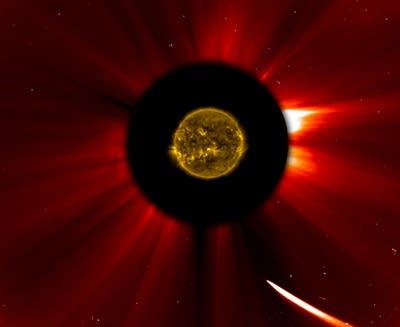ISON's fizzle fits the comet mold

Go Deeper.
Create an account or log in to save stories.
Like this?
Thanks for liking this story! We have added it to a list of your favorite stories.
When Comet ISON let down the sky-watching world over Thanksgiving, it was only doing what most comets do.
Astronomer Ken Croswell was not surprised by ISON's dismal showing. "I was pessimistic that it would be a great comet," he said on The Daily Circuit. "Great comets are rare. They only occur maybe once every decade."
Bob Berman had hoped for more. "It was an underachiever right from the beginning," said Berman, an Astronomy magazine columnist who led a group of stargazers to Chile to get the best view, and therefore suffered the sharpest disappointment. "It's hard for me personally not to hate this comet. ... We saw a faint blobby object rising in the constellation Virgo just before dawn. It was fainter than initial expectations. It was about 15 times dimmer than we had hoped ... We were lucky to see it at all."
"And yet still we had hopes that as it approached the sun, the sun's warmth would sublimate the ices ... all of this could produce a million-mile-long tail behind the comet, or even a double tail," Berman said. "And then after it whipped around the sun on Thanksgiving, that's when theoretically the tail could have really given us a beautiful show. But the question was: So close to the sun, was it going to survive or not? And most astronomers thought that it would, but some astronomers thought that it wouldn't.
Turn Up Your Support
MPR News helps you turn down the noise and build shared understanding. Turn up your support for this public resource and keep trusted journalism accessible to all.
"And it didn't."
Observers had hoped that ISON's tail would be easily visible from earth — even from urban areas, which is one of the criteria for designating a comet as "great." Instead, the comet remained obscure on its approach and was virtually undetectable afterward.
"There's only one great comet that's predictable," said Croswell. That one, Halley's Comet, is due back in 2061.
Most comets arrive unexpectedly because "there's no track record of their performance," Coswell said, and thus there is no predicting their orbit around the sun. "We only discover them, typically, a few months or a year or so before they become great. ... So it's entirely possible that the next great comet will appear in the next year or two."
"Most of these comets come from this vast reservoir of comets far beyond the orbit of the planet Pluto in the Oort cloud," Croswell explained. "There are estimated to be about a trillion icy bodies in the Oort cloud, and the Oort cloud probably extends out one or two light-years from the sun, so about halfway to the nearest star system, which is Alpha Centuri. ... Every now and then, one of those trillion objects happens to get nudged out of its position, maybe by a passing star, maybe by the gravity of the galaxy, whatever, and falls toward the sun ... and we have the potential to see a spectacle."
Scientists have a better shot at observing and predicting the movements of asteroids. One of them, Apophis, is expected to come close to the earth in 2029, and again seven years after that. The second pass may be too close for comfort, some observers suggest.
"The chance that it is going to hit the earth is tiny," Croswell said. "Observations we make in 2029 will better pin down its orbit, and hopefully astronomers will find that it's not about to hit the earth. But in the event that it is going to hit the earth, we'll have seven years to do something about it."
Added Berman, "People would do better worrying about cholesterol."
Astrophysicist Karl Battams wrote a memorial for the comet:
Born in a dusty and turbulent environment, comet ISON spent its early years being jostled and struck by siblings both large and small. Surviving a particularly violent first few million years, ISON retreated to the Oort Cloud, where it maintained a largely reclusive existence for nearly four billion years. But around 3-million B.C., a chance encounter with a passing star coerced ISON into undertaking a pioneering career as a Sungrazer. On September 21, 2012, ISON made itself known to us, and allowed us to catalog the most extraordinary part of its spectacular vocational calling.
Never one to follow convention, ISON lived a dynamic and unpredictable life, alternating between periods of quiet reflection and violent outburst. However, its toughened exterior belied a complex and delicate inner working that only now we are just beginning to understand. In late 2013, Comet ISON demonstrated not only its true beauty but a surprising turn of speed as it reached its career defining moment in the inner solar system. Tragically, on November 28, 2013, ISON's tenacious ambition outweighed its ability, and our shining green candle in the solar wind began to burn out.



